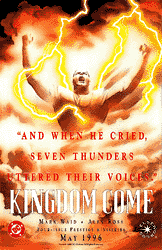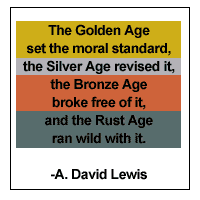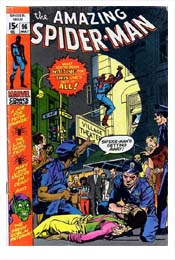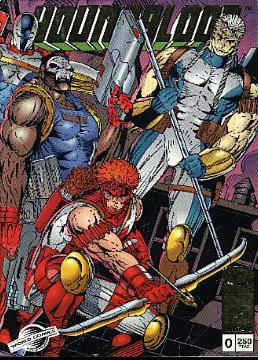|
Part
1, Part 2
One
For The Ages:
Barbara Gordon and the (Il)-Logic
of Comic Book Age-Dating
Part Three: Age of Iron or Age of
Rust?
Wizard
claims that "The Modern Age" did not begin
as much as default, being birthed from the orgy
of crossovers beginning with Marvel Super-Heroes'
Secret Wars where "team-ups lost their
specialness […] subsequently signaling the
end of the Bronze Age" ("One for the Ages",
2001: 91).
 Klock
considers a "Dark Age," a bastard spawn
of Watchmen's deconstructive tendencies -
"Alan Moore was disturbed to find people actually
liking Rorschach, and wanting to read more comics
that starred characters like him" (2002: 80).
Semich agrees to this assessment, even if under
the moniker of "The Iron Age," where much
of Superman's morality, optimism, and confidence
were siphoned away (which has only in recent years,
with writers like Grant Morrison on JLA,
begun to return). Klock
considers a "Dark Age," a bastard spawn
of Watchmen's deconstructive tendencies -
"Alan Moore was disturbed to find people actually
liking Rorschach, and wanting to read more comics
that starred characters like him" (2002: 80).
Semich agrees to this assessment, even if under
the moniker of "The Iron Age," where much
of Superman's morality, optimism, and confidence
were siphoned away (which has only in recent years,
with writers like Grant Morrison on JLA,
begun to return).
Ultimately,
though, Klock rejects both of those models, instead
proposing the Third and Fourth Movement of the genre:
a system of Oedpial narratives in the tradition
of theorist Harold Bloom where one generation's
heroes supplant the former (e.g. Watchmen, Authority,
Planetary). Coogan agrees that the movement
has been a four-step one, but he holds to a different
chronology. His Baroque/Iron Age "began with
DC Comics Presents #26 (October 1980), the
first appearance of the New Teen Titans," marked
by a "larger shift toward reinvigoration"
than ever before (Coogan, 1996).
Coogan
never quite defines what he means by "reinvigoration,"
but provides examples of it: "Self-conscious
revivals sprouted everywhere: the Fantastic Four
and Superman by John Byrne; Daredevil
and Batman by Frank Miller; Thor by
Walter Simonson; Captain Marvel and Marvelman
in Miracleman and the Charlton heroes in
Watchmen, both by Alan Moore" (1996).
These
examples, though, are highly problematic. While
Watchmen originated from a Charlton character
proposal, the ultimate product had little to do
with them at all. And Miracleman was a forced
alteration of Marvelman, caused by Marvel
Comics' lawyers on the British import. Further,
it becomes difficult to distinguish how these are
greater revivals that those of the Silver Age or
Bronze Age, some of which Coogan names to concede.
Coogan posits that a Second Golden Age now follows
the rather empty Iron one, where the staid superhero
conventions are reborn and experimentation lives
again.
In
a sense, his forecasting fulfills Busiek's own:
"I haven't heard anyone put together a decent
argument for another Age after Silver […] But,
I'm sure somebody will - I'm sure there's some sort
of organizing principle out there. Whether it's
writer-driven or artist-driven, it's always a cycle"
(Lewis, 2002). Franke and Wechsler-Chaput also admit,
"There is no clearly defined Age after the
Silver Age, although a number of possibilities such
as Platinum, Bronze, Independent, and (in more depressed
moments) Mylar and Silicon (the last based both
on computer coloring and the ever expanding female
breast size in many comics these days) have been
suggested" (1998).
 Bailey
follows the "mineral theme" to an extreme,
proposing "The Mica Age" and the "Electroplate
Age": "Mica" because "glitter
frequently contains little more than powdered, color
mica," referring to the cheap marketing gimmicks
of the late 90s, and "Electroplate" because
of its deeper-than-Silver penetration such as Kingdom
Come's admirable and "surprising discovery
of everything Kirbyesque" (2000). Bailey
follows the "mineral theme" to an extreme,
proposing "The Mica Age" and the "Electroplate
Age": "Mica" because "glitter
frequently contains little more than powdered, color
mica," referring to the cheap marketing gimmicks
of the late 90s, and "Electroplate" because
of its deeper-than-Silver penetration such as Kingdom
Come's admirable and "surprising discovery
of everything Kirbyesque" (2000).
To
summarize, one has a number of broad dates to use
as guidelines in moving, to use Bailey's phrase,
"toward a consistent nomenclature for the Ages
of comics" (2000). The Golden Age, with some
precursors, begins in June of 1938 with Action
Comics #1, the debut of our recognized Superman.
The Silver Age is after 1955, most likely September
1956 with Showcase #4, the debut of Barry
Allen as the revamped Flash. The next Age, which
I hesitantly call Bronze, comes as early as 1967
with Strange Adventures #205 (Deadman's first
appearance), but more likely between 1970 and 1972
for a multitude of possible reasons and events.
If there is a fourth Age, its beginning ranges from
1980 to the early 1990s, if it can even be said
to exist. The 2003 viewpoint of this article is
most likely too myopic to suggest a subsequent Age
without at least a decade of distance from which
to view it.
Systemical
Logistics for the Ages
It is now worth suggesting a particular perspective
from which to examine all of these aforementioned
theories: Consistency.
As
said in the opening, this article is more interested
in the logic behind these Age-systems than the systems
or dates themselves. And, for the most part, few
of these personal systems exhibit a consistent logic
all through their various stages; many manage to
isolate a range of years, such as the summary above
has just done, and then, within that span, seems
to find the event that holds the most impact to
them personally. In addition, there is a remarkably
strong bias towards formulating these Ages strictly
in terms of progress; the industry's backslides
and declines in are often relegated to either designations
like Bailey's "tribulations," or they
are overlooked entirely. While Bailey's "Mica
Age" may be a little extreme, it at least confronts
the declining standards of the comic book product
of that time, similar to the discarded "Dark
Age" perspective.
This
over-optimism and slapdash date-selection process
belies any application of hypothesis or scientific
method; to be useful to the academic and not just
the collector or fanboy, a degree of infused objectivity
is required.
Coogan
and Klock, regardless of their actual selections,
have the most consistent systems, with Semich a
distant third. Coogan's analysis is based on Schatz's
template, a very safe and wise procedure; while
one can dispute its application to comics as a medium,
to criticize its consistency would require deeper
familiarity with Schatz's own corpus and his work
as a whole. As it stands, Coogan remains true and
consistent to his source, straying only to extrapolate
and deduct what comes next. He looks for those moments
that best fit Schatz's mold; the only question,
then, would be whether Schatz's theory is appropriate
for this inter-media correlation.
Likewise,
Klock has his own mentor of sorts, Harold Bloom
(and, to a lesser degree, Slavoj Žižek),
and keeps his theory always front-of-mind. Any detours
into nostalgia or outside commentary are soon righted
by a return to his Oedipal paradigm. And, Klock
is further limited - said in a positive sense -
by focusing primarily on narrative rather than industry
fluctuations, social climate, or staffing changes.
Outside
of his mineral theme, Bailey holds to no steady
source of data. His examples run the gamut from
narrative-driven to industry-driven to marketing-driven.
The same holds for Wizard, Dashiell, and even Busiek
(though, given the chance to rebut, Busiek might
argue his focus to be on eras of experimentation,
which, in turn, argues against Coogan); first-appearances,
creator turn-over, price-increases, and audience-targeting
hold to no one (or two…or three) criteria.
And, only if one argues that Semich tracks shifts
in Superman's morality - an issue only made overtly
in his Iron Age section - can he be said to have
reasonable consistency. Format-driven, narrative-driven
(including both conventions and overall tone), price-driven,
staff-driven, society-driven, morality-driven, progress-driven,
aesthetically-driven, etc.: By what standard does
one judge the Ages?
 This
article has an answer, but certainly not the answer.
After all, the goal is not to create a new system
to beat all other systems - the intent is not to
slug it out with any of these aforementioned writers.
But, the following system (with Barbara Gordon in
the place of Bloom or Schatz) is proposed in order
to demonstrate how a consistent criterion can help
in rationally sorting through the Ages without totally
discarding the traditional Gold, Silver, Bronze,
and even Iron classes. This
article has an answer, but certainly not the answer.
After all, the goal is not to create a new system
to beat all other systems - the intent is not to
slug it out with any of these aforementioned writers.
But, the following system (with Barbara Gordon in
the place of Bloom or Schatz) is proposed in order
to demonstrate how a consistent criterion can help
in rationally sorting through the Ages without totally
discarding the traditional Gold, Silver, Bronze,
and even Iron classes.
To
demonstrate my personal logic, return again with
Action Comics #1. Again, it is highly significant
given its opening pages "fully employs the
definition of the superhero of mission, powers,
and identity. The very first page presents the origin,
analogical science (superhero physics), the costume,
the dual-identity, and the urban setting. In the
story itself emerge the secret identity, the superhero
code, the supporting cast, the love interest, the
limited authorities, and the super/mundane split"
(Coogan, 2001, my emphasis).
A
key but overlooked piece of Action Comics
#1 is the birth of the superheroic ethic: a morality
system that demands great power be used for the
greater good. In short, this is the reason why the
term "superhero" was coined following
Superman's debut and why Action Comics #1
is elected the genre's starting point. Golden Age
stories would tend "to be straightforward confrontations
between good and evil in which the superhero, society,
and the audience were all presumed to be on the
same side and working for the same goals,"
those goals being "the defense of the normal,
with defense of property rights and relations included
therein" (Coogan, 1998: 439).
 These
principles remain rather firmly in place, even as
the character who inaugurated them began to change
slightly. Coogan believes that "by the end
of 1940 nearly all traces of Superman's social conscience
have disappeared and he fights to protect property
against theft, politics against disruption, and
life against killing, thus enshrining the status
quo" (Coogan, 2001). These
principles remain rather firmly in place, even as
the character who inaugurated them began to change
slightly. Coogan believes that "by the end
of 1940 nearly all traces of Superman's social conscience
have disappeared and he fights to protect property
against theft, politics against disruption, and
life against killing, thus enshrining the status
quo" (Coogan, 2001).
Semich,
on the other hand, sees the 1940s version of Superman
as:
…essentially
a sort of "super-Roosevelt." He spent
most of his time helping to save people from natural
disasters or corrupt business men. He thought nothing
of leveling entire neighborhoods of slum dwellings
in order to force the city fathers to build decent
housing. He used his powers to terrorize munitions
makers who were, in his mind, the cause of all wars.
Except for the Ultra-Humanite and Luthor, there
didn't seem to be any supervillains for him to face
(Semich, 2003).
Coogan,
though, notes that writer "Mark Waid, who claims
to have read every single Superman story ever published,
asserts that the real shift in Superman's devotion
to social justice took place in 1945" (Coogan,
2001).
Whatever
its slope, Superman's core morality never truly
changed, even if the targets of his quest did. The
character helped to initiate the superheroic ideal
that strongly appealed to audiences at least until
the "impetus driving the Golden Age ended with
the Second World War […] with a surge in cancellation
occurring in 1949" (Coogan, 1998: 435). And
that impetus, arguably, could be the strong - almost
blind - adherence to the agreed-upon morality of
the American status quo.
By
using concepts of morality as a guide for the moment,
then Fredrick Wertham's publication of Seduction
of the Innocent becomes the most crucial event
in the post-war era for the superhero genre. Largely
because of both Wertham's popular outcry against
comic book's fallen standards and the Congressial
hearing on that matter, "the Comics Code Authority
was created, which mandated regulations that all
but sunk #1 publisher EC Comics by wiping crime
and horror comics off the shelves (some say it was
done intentionally by rival publishers to break
EC's stranglehold on the industry).
As
a result, the Code […] buried the Golden Age"
("One for the Ages", 2001: 87). However,
it also set the stage for superheroes reemergence
via an amended (and ironfistedly ordained) moral
code. Wizard says, "The comics industry
would be resurrected by trying to adapt to the Code's
rigid restrictions" (2001: 88), but that is
only half-true: the superhero genre would be resurrected,
dragging the industry along with it: "What
makes the Silver Age all the more amazing is that
it still turned the field on its ears despite working
within the rigid confines of the Comics Code. The
Code forced comics out of entertainment and more
toward morality and ethics…yet the Silver Age
embraced the restrictions and entertained nonetheless"
("One for the Ages", 2001: 94).
Once
again: by embracing the Comics Code's dictated morality
did the superhero genre survive. Thus, "DC
reinvented its classic heroes starting with Flash
in 1956's Showcase #4" ("One for the Ages",
2001: 94) paving a route to success by means of
the same Code that bound them.
Therefore,
the Golden Age begins with the implementation of
a morals-system for the superhero genre; the Silver
Age began with a forced revision of those waning
morals, namely the Comics Code. Can the Bronze Age,
with all its varied dates and events, be said to
have a precise relationship to the Code's dictated
sensibilities?
 Yes,
it can and does: Amazing Spider-Man #96,
dated June 1971. Written by Stan Lee, this issue
focused on the perils of drug use. However, since
the depiction of drugs - even when portrayed negatively
- violated the Comics Code, the issue went without
the CCA's seal of approval, making it to the newsstands
and readers' hands just the same. Yes,
it can and does: Amazing Spider-Man #96,
dated June 1971. Written by Stan Lee, this issue
focused on the perils of drug use. However, since
the depiction of drugs - even when portrayed negatively
- violated the Comics Code, the issue went without
the CCA's seal of approval, making it to the newsstands
and readers' hands just the same.
In
later years, Lee would be praised for his determination:
his "courageous action was endorsed by the
U.S. Department of Health because the Spider-Man
comics attracted a large number of young readers,
a segment of the population most at risk with respect
to drug abuse" (Entertainment Industries Council,
2003). While many underground, independent creators
thrived without the CCA approval, this was the first
instance of a mainstream superhero publisher willingly
defying it in favor of a higher morality. "The
Comics Code Authority subsequently changed its rules
to support the inclusion of anti-drug abuse messages
in comics" ("One for the Ages", 2001:
91), indicating that the power to determine comic
book ethics had swayed: By the climax of the Bronze
Age, it now belonged largely to the publisher, the
main force in shaping a book's destiny and sensibilities.
"By
the mid-1980s the Comics Code, once a force powerful
enough to bring even EC's William Gaines to heel,
had become a spent force, with both Marvel and DC
insouciantly advertising many of their comics as
'Suggested for Mature Readers'" (Reynolds,
1992: 9). The Bronze Age is also marked by the onset
of "relevant comics," those that focused
on the issues then eating at America, such as trust
in government, equal rights, and foreign policy.
Many titles from this team of publishers had lead
the charge in addressing these topics, and those
books that did not were often exploring the creative
boundaries of the genre.
However,
by the 80s, that freedom had become irresponsibility.
The Code was flimsy, and there was little fear of
its violation. Marvel Comics and DC Comics - the
Big Two - operated largely as their own censors
(even though they remained part of the CCA's committee).
And, after fourteen years of determining their own
borders, the self-policing suddenly turned lazy
when Watchmen and Batman: The Dark Knight
Returns showed there was money to be made in
compromised heroes.
Certainly,
this was not Moore and Miller's intention, but it
was their effect. For at least a half-dozen years,
Marvel and DC released the reigns on hero's accountability
in favor of profit. Darkened heroes ruled the day
and "heroism itself was questioned by the psychotic
characterization of many heroes […] Heroes
seemed to serve themselves more than society"
(Coogan, 1996) It could be called an "Iron
Age" or a "Dark Age", the "Amoral
Age" or a "Tarnished Age", but perhaps
calling it a "Rust Age" for all of its
forebears serves just as well to illustrate the
point without sacrificing the metallic theme.
The
Golden Age set the moral standard, the Silver Age
revised it, the Bronze Age broke free of it, and
the Rust Age ran wild with it. The irony, it seems,
is that one of the worst offenders of this Rust
Age also serves as the most logical starting point
for the last identifiable Age.
Coogan
claims, "The Iron Age of superhero comics is
marked by numerous deaths of superheroes […]
Perhaps most emblematic of the death of the superhero
is the Iron Age's self-proclaimed greatest success,
Spawn, the corpse as superhero" (Coogan,
1996)
What
he fails to acknowledge is the fact that this emblematic
hero came not from the Big Two, but from a company
formed by "seven renegade comic artists [who]
shocked the comics establishment by walking away
from mega-giant Marvel Comics to form Image Comics
in 1992" ("One for the Ages", 2001:
92).
 The
content of their books, for example their premiere
Youngblood #1 in April 1992, was largely
of the same grim-and-gritty anti-hero variety, if
not even more vacant of ethical values. But, the
formation of Image Comics echoes the same preliminary
break Marvel made with the CCA twenty years prior:
the Big Two could no longer lay sole claim on the
ethical standards found in mainstream superhero
titles. And while the founders of Image may not
have produced the creations (e.g. Spawn, Youngblood,
WildC.A.T.S., Savage Dragon) that critics might
embrace as the next generation of the superhero
genre, they did up the ante and challenge the long-undisputed
Big Two throne. The
content of their books, for example their premiere
Youngblood #1 in April 1992, was largely
of the same grim-and-gritty anti-hero variety, if
not even more vacant of ethical values. But, the
formation of Image Comics echoes the same preliminary
break Marvel made with the CCA twenty years prior:
the Big Two could no longer lay sole claim on the
ethical standards found in mainstream superhero
titles. And while the founders of Image may not
have produced the creations (e.g. Spawn, Youngblood,
WildC.A.T.S., Savage Dragon) that critics might
embrace as the next generation of the superhero
genre, they did up the ante and challenge the long-undisputed
Big Two throne.
The
precipitous rise of CrossGen, Oni Press, and even
Big Two prestige imprints like Wildstorm (which
was originally part of Image -- ed.) and Marvel
Knights owe their voices to Image; it is a stronger
Age where the spectrum of morality can be represented
- a stronger Steel Age.
In
closing, it is worth citing a favorite title amongst
the various sources used above: Busiek's own Astro
City from Homage Comics, one of the post-Image
upstart subsidiaries of Wildstorm and DC. Astro
City #1/2, "The Nearness of You",
is considered a "critically important moment"
by Klock as it recounts "the story of Michael
Tenicek, who is plagued by dreams of the same woman
every night" (2002: 88). This woman, it turns
out, was Tenicek's wife before a superhero conflict
imperfectly rewrote reality; her existence was lost
in the shuffle, and her only remaining trace exists
in Tenicek's dreams. When given the choice by the
supernatural Hanged Man to have her purged from
memory or leave that last remnant of her alone,
Tenicek chooses to remember. He finds peace from
this rational explanation and, from there, is willing
to accept the imperfections of his existence.
In
some way, perhaps this article's guide is just as
much Michael than Barbara. "While Miller's
Batman needs to create order, and Moore's Joker
finds madness in acceptance, Michael Tenicek finds
peace through understanding, not by forgetting,
but through memory" (Klock, 2002: 89). Hopefully,
that same serenity will guide further the systems
of logic in remembering the Ages.
Page
4: Chart and Citations
--
A. David Lewis

|